Osuna is one of those towns you're not
likely to visit unless you stay 5 weeks in Andalusia. It's about an
hour from everywhere: Granada, Seville, Cordoba, and Malaga -- Central,
but distant, and seemingly not worth the trip -- until you make it and
then fill up your friends' email boxes with pictures. The hills around
burst with neat rows of olive trees in arid terrain similar to the
cactus-spattered hill in the picture below. In the 17th century, this
land hid the bandoleros -- outlaw gangs with some of the mythic charm
of Robin Hood who, in fact, preyed violently upon Andalusia trade
routes.

Caesar’s Last Stand
Today all is calm and much is white as Osuna shows off its stately
churches, noble homes, and even a bit of its Roman roots stretching
back to the days when the place sided with Pompeii in his civil war
against Julius Caesar. In fact, this was the site of Caesar's last
battle (if we ignore that unfortunate "Et tu, Brute" incident on the
Senate floor a year later.)
The Dukes Pearl
This town got so polished because some uppity counts traded for the
place -- and then invested to make their social climbing possible. They
ended up as some of the most powerful dukes in Spain. The Osuna Dukes
had done a real-estate swap for their future home with the Order of
Calatrava -- a branch of the Cistercian monks who fought as Knights.
(Not all monks prayed, some had to convert heathens through other
methods up to and including death.) Since Osuna had an advantageous
hilltop position on the border between Christian territories and the
Moors capital of Granada, the King ceded them this frontier town in
1264 -- hoping they would hold it.
The monks rebuilt Osuna
as a fort. Eventually the Moors
were permanently driven out and the area became safe for
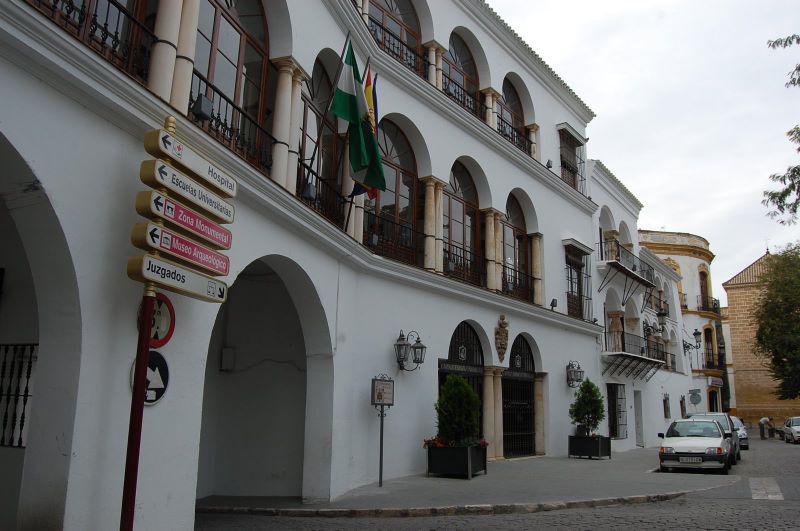
respectable (and social climbing)
nobility during the 15th century. With the fall of the Moors, the King
took over the order and gutted it, leaving in place pretty much an
honorary society for nobles. One of them, the count of
Ureña, Pedro Téllez de
Girón, swapped other territory to get this town for his
family. After the swap, his successor counts made this now peaceful
site into an elegant showpiece to help convince the king that such a
beautiful town deserved a dukedom, which Philip II eventually
established.
The Tellez-Girón Dukes’ fortunes rose. At least
two of them served as the viceroys (governors) of Naples,
then the
2nd largest city in all of Europe
and under the Spanish crown.
By the end of the 16th century, the Dukes had the 2nd largest estate in
Spain.
The 3rd Duke was quite a character: Pedro
Téllez-Girón (1575 – 1624) served as
viceroys of Sicily (also a Spanish possession) and then Naples. At
least as reckless as he was talented, he died under house arrest and
his dukedom remained in eclipse for decades afterwards.
Despite that, he is known as "Osuna el Grande”
-–the
great
Duke of Osuna.
Barefoot in the Chapel
Our day started at an old hospital which since 1626 has been a cloister
for nuns. Inside it's also a museum of sacred art and has one of the
most complete Sevillian ceramic series anywhere. The fourth Duke of
Osuna (Juan Tellez Giron) founded the place in the 17th century. For 2
Euros each, we had two nuns as personal guides -- one ample and jovial
and the other tiny and fascist. Grade school
deja vu!
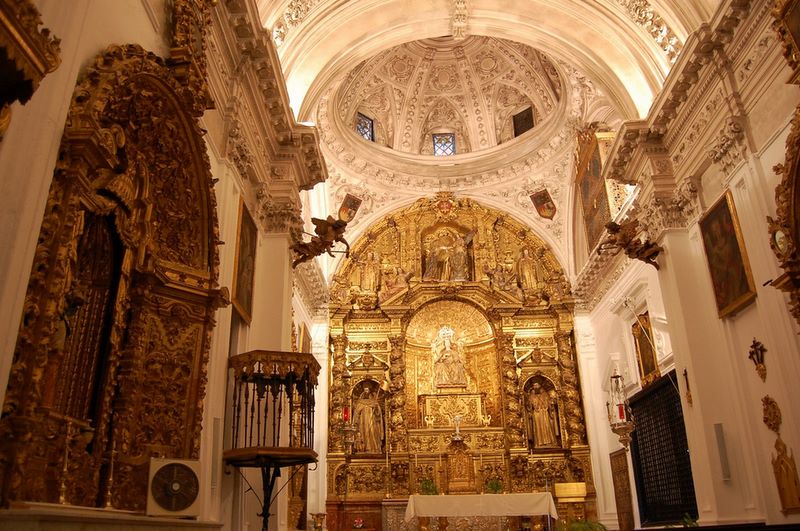
Discalced or Barefoot Carmelites typically wear sandals, as did our two
guides. Ours also wore socks and full nun habits, and spoke only
Spanish except for their NO PHOTOS! However, we were allowed to shoot
pictures
in their chapel (above) just off their entrance where, like many
Spanish convents, they sell sweets
to support themselves. The NO PHOTO rule held behind their
cloister and in the museum rooms, not to mention the ceramic series
which was technically outside.
After the chapel tour, the nuns took us through the adjoining museum
room-by-room: opening doors and turning on lights as they showed off
their collection of religious art, especially statues, some with
various outfits which were changed with the feast days. The
piece de resistance
(if they have such a thing in Spain) is the
extensive tile dado in the cloister and stairways symbolizing the five
senses. (NO PHOTOS said the little nun – again!)
The Colegiata
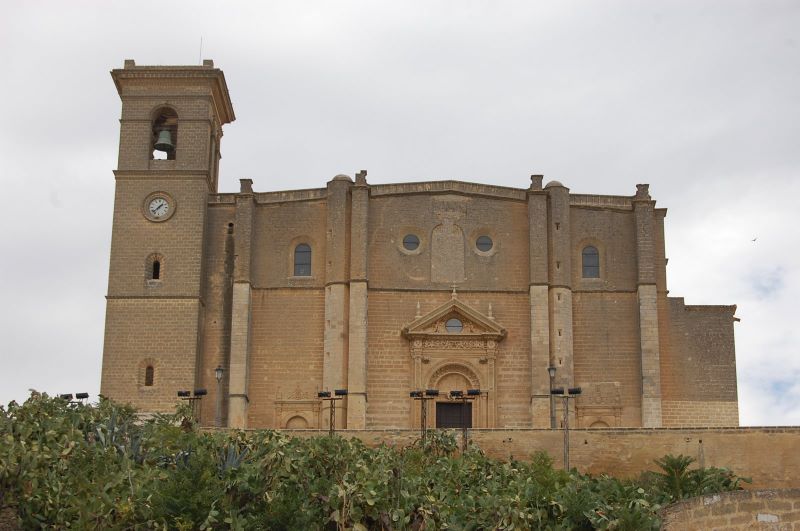
Next we walked up the hill to the Renaissance jewel in the very plain
wrapper -- The Collegiate Church of Santa Maria de la
Asunción . A Collegial church is one which is not a
cathedral. This once was part of the university behind it (now a
secondary school after the reactionary Fernando VII shut down such
liberal hotbeds in the 1800s.) The outside is monotonous ecru stone
blocks except for its west door of the sun (Puerta del Sol) with its
sculpted Plateresque doorway (below) which seems to be
semi-restored.
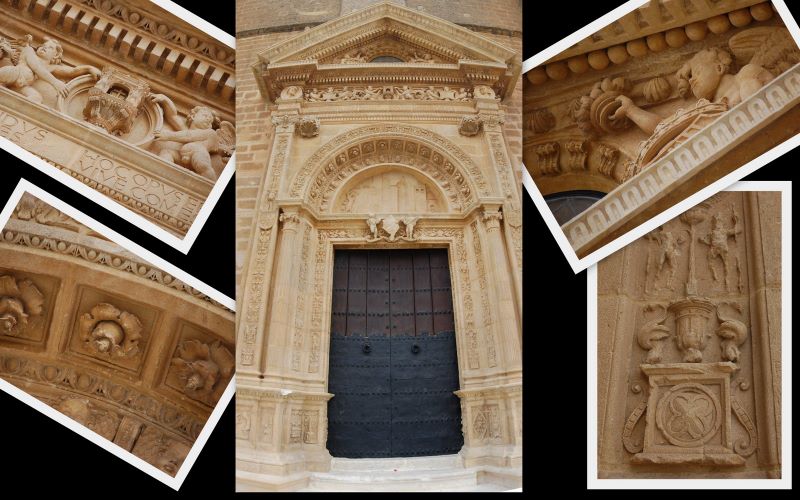
The word Plateresque has roots in the Spanish word for silversmith and
refers to the delicate, almost metal-worked, decorations. This
particular door is thought to be inspired by the Plateresque details in
the Spanish city of Salamanca. Rumor holds that Napoleon's troops used
this portico for target practice.
In order to claw their way to the top of the Spanish nobility, the
Girón dukes spent lavishly, hiring the best artists from
Seville, 60 miles away. This church is the work of two of them: Diego
de Riaño and Martin de Gainza who did that city's iconic
city hall and Andalusian parliment building, respectively. (We'll post
those pictures soon). Unlike this
building, both of those Seville structures have elaborate plateresque
exteriors. Inside, the Collegia's five naves switch back and forth from
Renaissance arches to Baroque altarpieces:
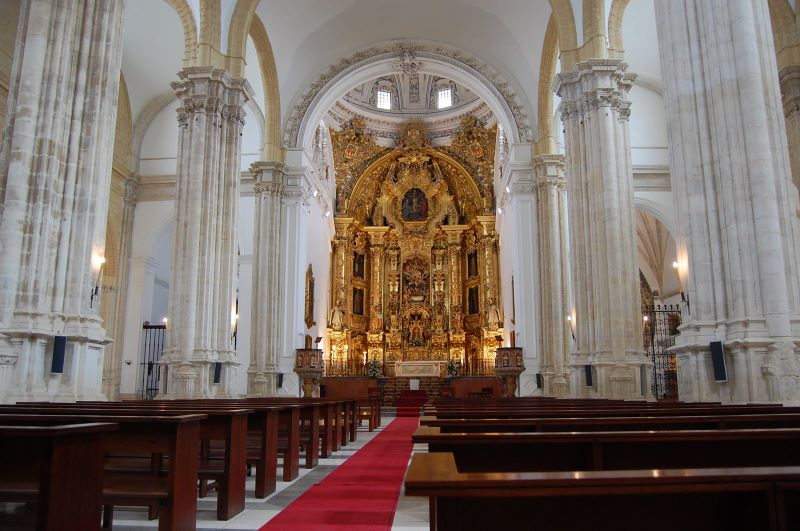
This ground level is magnificent; below it's even better as
the 4th duke of
the powerful Girón family created this church and the
university behind it as a memorial to his parents; next, he built a
mausoleum for the family underneath the apse starting around the mid
1500s.
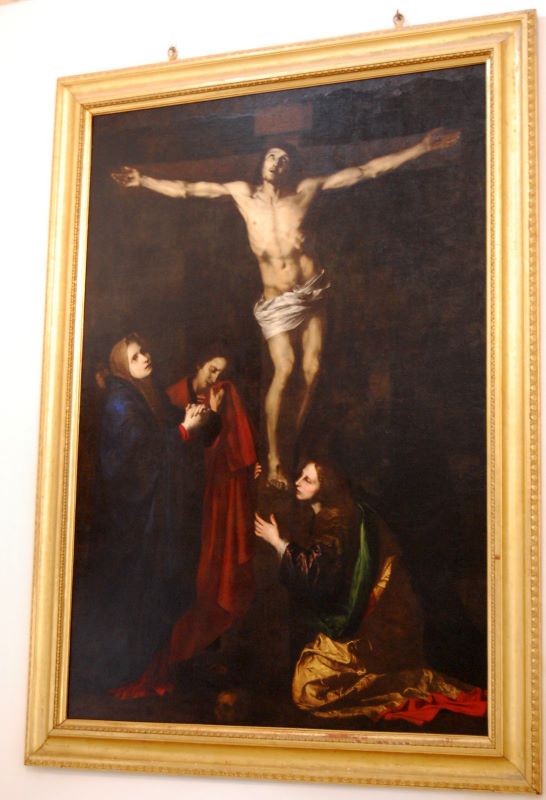
In addition, a huge sacristy is now a museum with, among other
jewels, four early paintings by Jose de Ribera (1591- 652). But just
inside the nave door of the church is one of the most important works
of this master, known as
Lo
Spagnoletto -- the little Spaniard.
(Although unsigned and undated, this naturalistic Crucifixion with its
treatment of flesh and cloth is unarguably Ribera and likely done in
1618.) Born in Spain, he spent most of his life in Naples -- which was
under the Spanish crown during his time. For a while it was run by the
Duke of Osuna who probably commissioned Ribera to fill up his home
church with such paintings. (Other Osuna dukes and duchesses were
likely involved, as well). Ribera was a fellow traveler of the older
Caravaggio in that dark and light stuff called tenebrism.
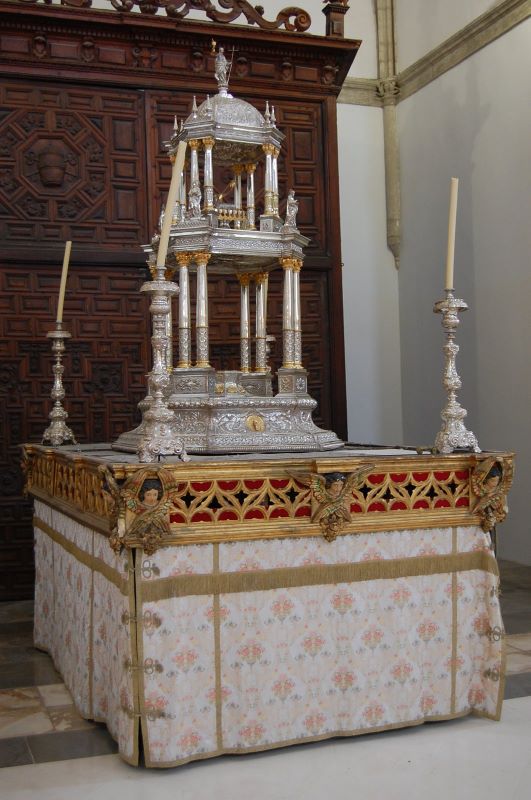
Here's an elegant silver float carried
during processions. Most churches brag about how big their
organs are (this may be a guy thing). Instead, The Colegiata has one of
the smallest –but it can be carried during processions, an
18th century variant on the marching band theme that may have inspired
Woody Allen's Cello marching band in
Take the Money and Run.
These
candles could use a little Viagra in the holy water as well.
We ended our visit to the Collegiate church in its masterpiece: the
tombs of the Dukes. Unfortunately, photos weren't allowed; since this
lovely cloister was technically outside, I thought I could sneak this
one in. (See below) This small square space (15' per side) has been
recently restored -- but I can't believe that the original architect
intended that upper railing to be there. Although Italian inspired,
this atrium is considered to be one of the outstanding examples of the
Spanish Renaissance. Note the triangle of the red-and-gold beamed
ceiling showing at top center. The Dukes' Mausoleum itself could be the
most interesting spot in town (but no photos allowed.) It claims to be
the smallest --25' X 15' X 8' high -- cathedral in the world. (The
choir has 9 sculpted seats). It has a bit of a bizarre Gothic feel to
it with a polychrome ceiling now whose blue has turned to gray with
centuries of candle smoke
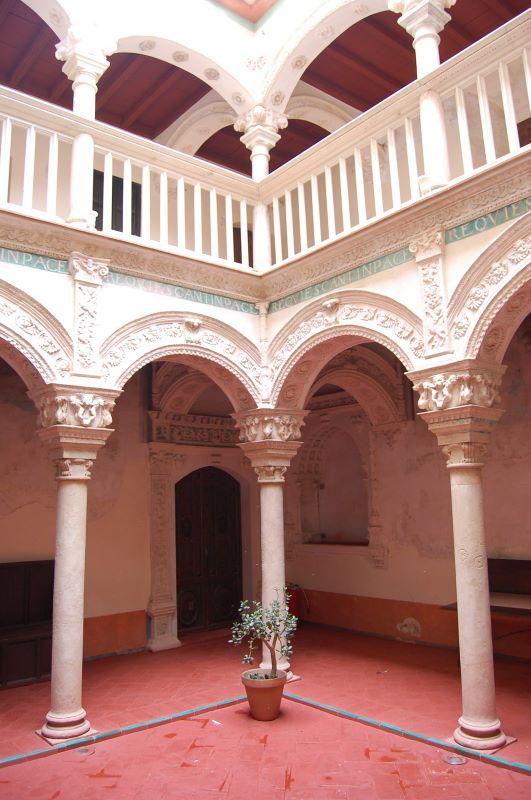
Walking through the Duke’s town
Near the two art museums/churches is the town's main square, the
spacious Plaza Mayor (see below), flanked on one side by a colonnaded
city hall: the Ayuntamiento (see the picture of the arcaded building
near the top of this page). Signs are plentiful and traffic flows
reasonably well right through the building. Unlike most Plaza
Mayors, Osuna's seems to lack the outside restarants
and bars flowing onto the plaza from the surrounding retail
establishments. (Maybe we should return some summer to check this out
again.)
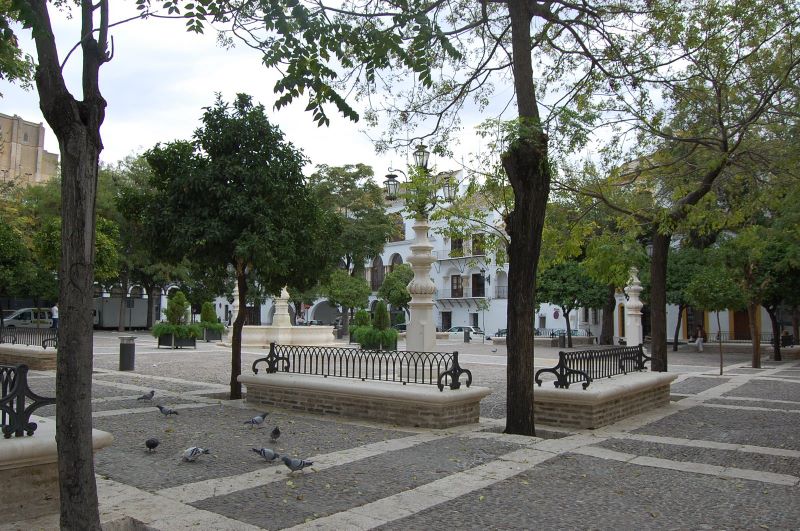
Upon these rocks were built the Calle San Pedro
The Girón family’s efforts paid off. Not only did
the town (and they) get its Dukedom, this duchy became one of the most
influential in all Iberia. Consequently wealth flowed back to the town,
allowing for the construction of beautiful public and private
structures. San Pedro Street features many of them.
The Cilla del Cabildo
This 1773 Baroque palace called Cilla del Cabildo (above right) honors
nearby Seville: a model of its famous Giralda rises between flowerpots
(representing the cathedral of Seville) and statues of Sts. Justa and
Rufina (above left -- but you may have to click on that picture to
enlarge its detail). These were 3rd century Sevillian sisters and
martyrs from the days when Christians were still being fed to lions.
(Rufina
actually was, but the lion turned into a pussy cat and so she was
beheaded
instead). These sisters traditionally guarded this famous tower through
the centuries (probably starting
after the Moors erected its base as a minaret before abandoning the
town to the Christian reconquest.)
The Cilla del Cabildo has an exquisite Plateresqe facade augmented by a
little graffiti on its sign and the ever present parked cars to
frustrate photographers. These unusual pilasters are typical of its
architect, Alonso Ruiz Florindo
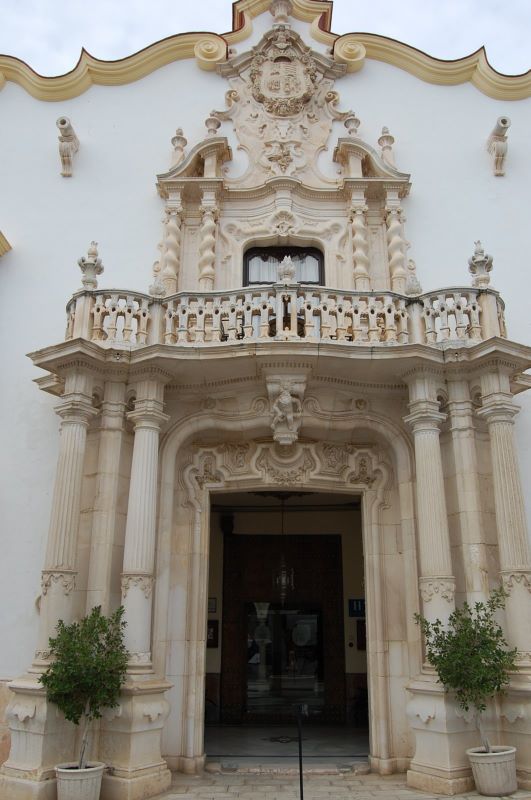 Palacio de los Marqueses de la Gomera
Palacio de los Marqueses de la Gomera
Down the street a
block or so is the Palacio de los Marqueses de la Gomera, sporting
another 18th century Baraoque facade where delightful curves run
rampant. With the marquis long gone, it's now an upscale hotel. The
front cornice of the Palacio de los Marqueses de la Gomera built around
1765 is crowned by the Marquis' family crest. This building is
considered the most representative of secular Baroque architecture in
Osuna (but still contains a cloister and chapel!) It was designed by
Juan Antonio Blanco.
Today the Dukes of Girón are long gone, but the town they left
behind proudly preserves its baroque core and welcomes tourists to this
somewhat out-of-the-way spot. Lots more pictures are available on
the slideshow. (See below)
Please join us on the following slide show to give
Osuna the viewing it deserves by clicking here.
|
|
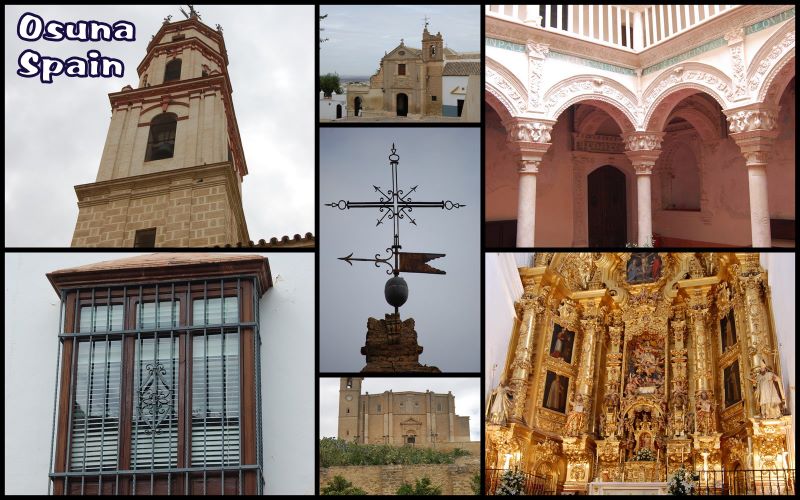

 respectable (and social climbing)
nobility during the 15th century. With the fall of the Moors, the King
took over the order and gutted it, leaving in place pretty much an
honorary society for nobles. One of them, the count of
Ureña, Pedro Téllez de
Girón, swapped other territory to get this town for his
family. After the swap, his successor counts made this now peaceful
site into an elegant showpiece to help convince the king that such a
beautiful town deserved a dukedom, which Philip II eventually
established.
respectable (and social climbing)
nobility during the 15th century. With the fall of the Moors, the King
took over the order and gutted it, leaving in place pretty much an
honorary society for nobles. One of them, the count of
Ureña, Pedro Téllez de
Girón, swapped other territory to get this town for his
family. After the swap, his successor counts made this now peaceful
site into an elegant showpiece to help convince the king that such a
beautiful town deserved a dukedom, which Philip II eventually
established.




 Here's an elegant silver float carried
during processions. Most churches brag about how big their
organs are (this may be a guy thing). Instead, The Colegiata has one of
the smallest –but it can be carried during processions, an
18th century variant on the marching band theme that may have inspired
Woody Allen's Cello marching band in Take the Money and Run.
These
candles could use a little Viagra in the holy water as well.
Here's an elegant silver float carried
during processions. Most churches brag about how big their
organs are (this may be a guy thing). Instead, The Colegiata has one of
the smallest –but it can be carried during processions, an
18th century variant on the marching band theme that may have inspired
Woody Allen's Cello marching band in Take the Money and Run.
These
candles could use a little Viagra in the holy water as well. 

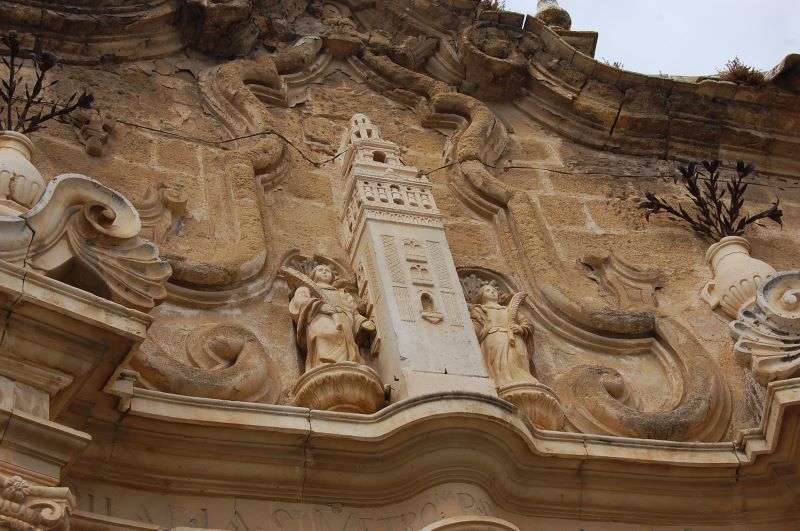
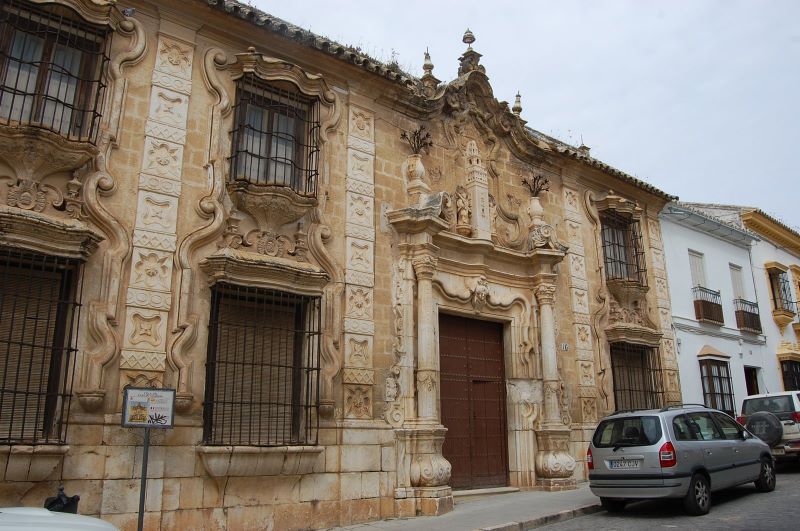
 Palacio de los Marqueses de la Gomera
Palacio de los Marqueses de la Gomera